[This is a continuation of our previous blog which was too enormous to load on at one go! It starts with our afternoon adventures.]
We had arranged to meet at István's home at 2pm so made our way their stopping at a little bar outside the town for coffee. We have the definite impression that they didn't get many English tourists wandering in asking for coffee in Hungarian. It was good coffee served in thick glasses and cost about 15 pence each! We sat with a few of the barman's regular customers watching Hungarian TV as the rain streamed down outside.
As it eased we ran along the road, jumping the puddles to arrive only five minutes late. István was distressed about the weather but we said it would be good anyway so off we drove out of the city and across the flat plains described earlier and on to Hortobágy, a small village in the centre of this empty region. Here we explored a fascinating little museum about the social history of the plains and the horsemen who lived nomadic lives with their animals as they moved around. This is a way of life that had almost ceased now though there are still large flocks of sheep with long twisted horns and herds of grey cattle with magnificent curved horns. They are still controlled by skilled horsemen and dogs. The museum showed models of the temporary dwellings set up by the herdsmen, constructed from tall reeds which are everywhere in this waterlogged plain. Reeds supplied the materials for animal shelter too, from the freezing snows and icy winds of winter and from the baking heat of the summer sunshine. (Normally in June temperatures are well up into the thirties with no shade. Today though we were around seventeen). A video showed footage of an earlier age with sheep shearing, horse racing and cattle ranching.
 Herdsman's hut in the museum, Hortobágy
Herdsman's hut in the museum, Hortobágy Shepherd in the museum, Hortobágy
Shepherd in the museum, HortobágyIstván had arranged a trip out into the Puszta (plain) in a horse drawn cart with a German speaking guide for us. We were joined by a French family, the husband being Hungarian, so we dispensed with the German and worked in French and Hungarian. That way everyone could understand okay. It was a wonderful experience with lots of laughter as we all juggled between several languages.
 István, Iboyla, Jill and a Hungarian Frenchman, Hortobágy
István, Iboyla, Jill and a Hungarian Frenchman, HortobágyThe horses pulled us through the oozing mud and reeds, axle deep in water at times. Out on the plain was a long low, thatched barn building surrounded by flocks of brown sheep. A cart pulled by long-horned cattle was driven towards us by a shepherd in the traditional Hungarian costume of the Hortobágy plains – wide blue trousers, boots, a black embroidered waistcoat and hat. Of course the main attraction was the horses and their riders. They looked magnificent as they trotted over to us. Having cantered around, one costumed driver took five bare-back horses in hand and tore across the plain standing astride the back two, his blue clothes flying out behind and his long decorated whip cracking over the horses head. It was awesome seen in its natural setting! Several riders then showed off their skills with the horses. In the past some of these plainsmen used to be animal rustlers and highwaymen so had taught their horses how to hide on a wide open plain by lying down flat in the reeds, hidden from sight. Obviously this is now a tourist attraction but it was magnificent just the same and the skills of today's horsemen are just as remarkable. The horsemen offered us rides but Jill was the only one willing to have a go. With only a saddle that lacked girth straps – designed for a quick descent which Jill indecorously proved to be effective – she lacked some of the finesse of the experts but it was a great experience. The horse was huge but very calm and intelligent. Being led around very gently by the reins was reminiscent of childhood donkey rides on the sands at Margate!
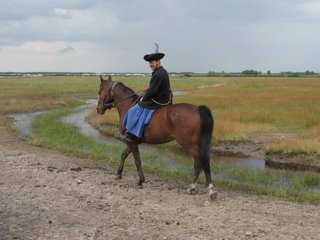 Horseman riding by, Hortobágy
Horseman riding by, Hortobágy Herdsmen with animals, Hortobágy
Herdsmen with animals, Hortobágy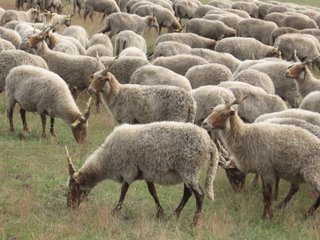 Sheep with twisted horns, Hortobágy
Sheep with twisted horns, Hortobágy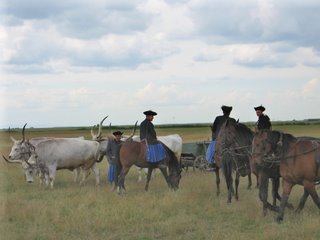 Herdsmen of the plains, Hortobágy
Herdsmen of the plains, Hortobágy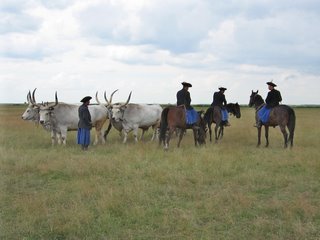 Herdsmen with cattle, Hortobágy
Herdsmen with cattle, Hortobágy Five in hand, Hortobágy
Five in hand, Hortobágy It was all so skillful, Hortobágy
It was all so skillful, Hortobágy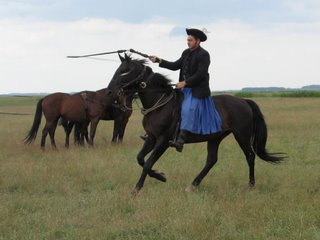 Whip crack-away, Hortobágy
Whip crack-away, Hortobágy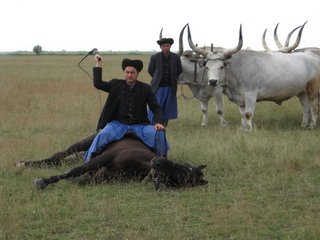 Cracking the whip while the horse munches the grass! Hortobágy
Cracking the whip while the horse munches the grass! Hortobágy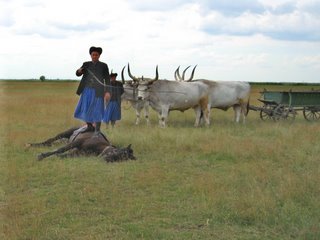 Still cracking and munching! Hortobágy
Still cracking and munching! Hortobágy Never seen a horse sitting before. Hortobágy
Never seen a horse sitting before. Hortobágy Now watch the expert! Hortobágy
Now watch the expert! Hortobágy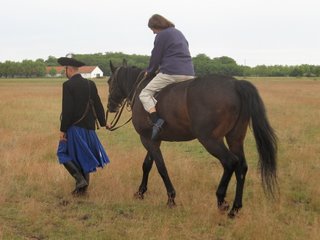 Aspirations for a new career in retirement! Hortobágy
Aspirations for a new career in retirement! Hortobágy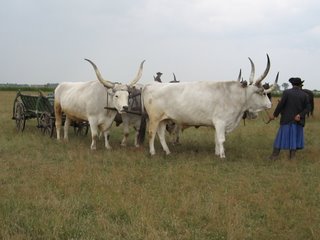 Cattle at work, Hortobágy
Cattle at work, Hortobágy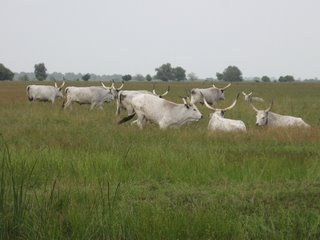 Long-horn cattle grazing, Hortobágy
Long-horn cattle grazing, Hortobágy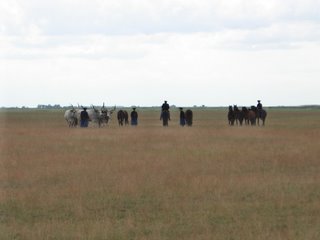 Movement out on the empty plains, Hortobágy
Movement out on the empty plains, HortobágyThen the rain started in earnest and we clambered back into the open sided cart and sloshed our way back across the plain. (No doubt leaving the horsemen to return to the low thatched barn with their sheep, horses and cattle, to listen to their Ipods, play on their laptop computers or phone mum in Budapest on the mobile until anyone else wanted to come out across the swampy ground to observe their nomadic lifestyle!)
We were very wet by the time we got back to the car despite our rainwear. István then took us to a local csárda for an early supper. This building was in typical Hungarian style – long, low, thatched with whitewashed walls and geraniums at the windows. Inside the walls were hung with folk-art ceramics and the wooded tables were covered in thick brown and white woven clothes in typical Hungarian designs. It was warm and dry with a huge ceramic stove in the corner. Here we had glasses of deep red country wine and dishes of Hortobágy beef pancakes in a mild, sweet paprika sauce. Feeling content and glowing from a wonderful day we were astonished when the waiter appeared with another huge dish laden with every type of Hortobágy speciality. We must have been served with half the total production of the region! It was enormous! Surrounded by tomatoes, rice, potatoes, gherkins and pickled cabbage lay a mountain of baked ham, salami, mutton ribs, chicken legs, fish from the Hortobágy river and huge pieces of beef! István and Ibolya were determined we would not leave Hungary hungry!
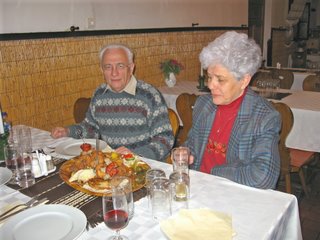 István and Ibolya in the csárda, Hortobágy
István and Ibolya in the csárda, HortobágyReturning to Debrecen we stopped to climb a watch tower, important during summer to detect fires starting far across the plain. We are assured that normally in August the plains are tinder dry. From the tower we had views all around. Not a hummock in sight and flatter than a Hortobágy pancake!
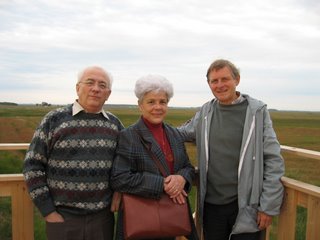 István, Ibolya and Ian on the highest place in the Puszta
István, Ibolya and Ian on the highest place in the PusztaOn the way home István decided we should see Hajdúszoboszló, a spa town and health resort west of Debrecen. The sun was setting as we arrived, bathing the hotel facades in a rosy glow. This attractive little town is a favourite resort for István and Iboyla and they are frequent weekend visitors to the spa complex. Strolling through the pretty gardens with their borders of bright busy-lizzies we discovered an installation of 50 bells artistically displayed as a garden feature.
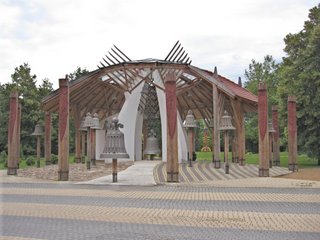 Bells at Hajdúszoboszló
Bells at HajdúszoboszlóWe were dropped off at the University medical campus where, attracted by the churning sound of a washing machine we have discovered the students' laundry room complete with tumble dryers. This has provided us with a very convenient opportunity to catch up on washing duvet covers and towels, impossible on campsites when the weather has been so bad.
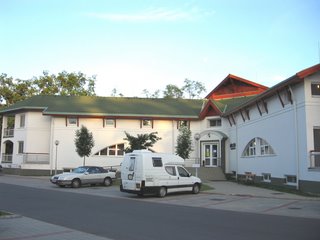 Modestine goes to Medical School, University of Debrecen
Modestine goes to Medical School, University of DebrecenThursday 8th June 2006, Debrecen, Hungary
Opening the door of our room this morning we found doctors already hard at work in their offices along the corridor. István looked very official in his white surgical coat seen through his open office door as he sat at his computer preparing his lecture for the conference on paediatric endocrinology he will be attending tomorrow. There is sometimes a slight sense that we are living in a somewhat surreal world here, taking on new experiences all the time. A couple of days ago we had no idea that we would be tumble-drying our laundry in a medical centre or riding horses on the Puszta.
Mid-morning István discarded his white coat and joined us for a visit he had arranged at the University Natural Sciences Library. The following paragraphs may be skipped by anyone who is not a medical librarian but is gripping, envy-inducing stuff for those who are. This is a brand new building integrating the scattered resources of the different departmental libraries – biology, biochemistry, medicine, agriculture, physiotherapy and public health. The librarian gave up her morning to us, guiding us around the building and answering our questions in perfect, fluent English despite never having visited Britain! Debrecen is one of the two national copyright libraries in Hungary and there are projects under way to digitise certain medical text books and exam papers which are made available to Debrecen students on the internet. There is no nationally co-ordinated approach to healthcare information provision so it appears there is much duplication of work and resources with other libraries carrying out similar projects. The library currently subscribes to around 8,000 medical and health care journals, the majority being in the English language. Dream-on Exeter! Being a national copyright library these are all bound and kept permanently. Around 35,000 interlibrary loan requests are satisfied annually. Access is available across all campuses to a massive range of full-text journals supplied by aggregators, mainly Ebsco and Science Direct. Funding for health sciences libraries seems very generous at the moment. Certainly medicine has a very high profile in Hungary. Seeing what is available here, what must the Hungarian doctors have thought of our poor underfunded library when they relied on our resources for their research during their year in Exeter? There are ways though in which we make far more efficient use of resources, primarily through our system of regional and national co-operation, avoiding much duplication of work, storage, conservation and resources. Like us too, the library staff find working with journal publishers a total nightmare with the goalposts being moved as soon as they are set up. Their biggest moan is that whenever it happens the end users seem to think it is entirely the fault of the library staff. I'd forgotten how good it was not to have to worry about such matters. Sorry Paula, I know you will sympathise. The Natural Sciences library has around 400 computer spaces and wireless enabled facilities for countless laptops.
 Natural Sciences Library, University of Debrecen
Natural Sciences Library, University of Debrecen Reading room, Natural Sciences Library, University of Debrecen
Reading room, Natural Sciences Library, University of DebrecenNext István had arranged a visit to the main university library on a different campus. Debrecen has always gone in for buildings on a gargantuan scale and the University is no exception. Inside and out it beggars belief that anything could have been built on such a scale and so elaborately designed and finished as late as the 1920's. Money was certainly no problem at the time. Even today, when funding is set to be reduced, István tells us that the University budget is nearly as great as that for the entire city of Debrecen!
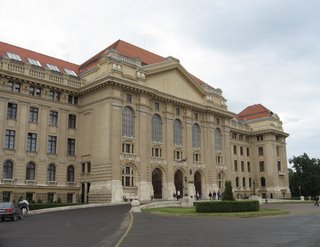 Main University building, Debrecen
Main University building, DebrecenAgain we were shown around the University library by a librarian with an excellent command of English. It is in process of restoration but we were shown the main reading room where István pointed out where he spent much of his student youth as he studied as an medical undergraduate here. We think he rather enjoyed accompanying us as it brought back happy memories for him.
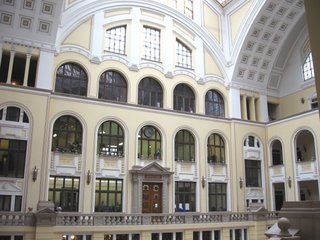 Library entrance within closed courtyard, University of Debrecen
Library entrance within closed courtyard, University of Debrecen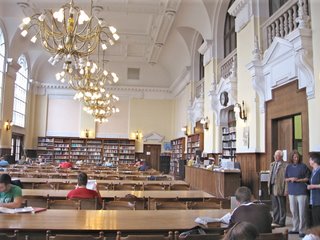 Main Library reading room, University of Debrecen
Main Library reading room, University of DebrecenAs Jill talks with the librarian István looks with nostalgia to the seat he traditionally occupied as a medical student.
The library is still on closed access with multi-storey stacks at each end of the main reading room, where the entire stock is arranged by size, items being assigned running numbers. There are huge banks of card catalogues, the contents gradually being transferred onto the OPAC. Users consult the catalogues, fill in slips and wait for 30 minutes while staff search the shelves and bring them the required items! Jill was amazed such practices still exist in academic libraries. Fortunately this is gradually being changed with more material on open access. Ian was particularly interested to see the early books. They certainly have an enviable collection but the items are in rather a poor state of repair and funding is not available for conservation. In any case there are few local conservation facilities, rare items being sent to the National Széchenyi Library in Budapest.
Okay the rest of you, you can start reading again now.
We returned home with István for lunch. Ibolya had returned from work and somehow found time to prepare us a delicious pork stir-fry with vegetables and rice. Then, determined that we should not sink into retirement and forget libraries, István guided us down into town on the rattling old tram, to the Reformed College where he had arranged a visit for us to see the outstanding Great Library.
We were met at the massive doors by a member of the library staff who conducted us around the departments at a cracking pace, producing a bewildering amount of information at speed – and in English. The exhibition of ecclesiastical art and the general college museum contained many treasures reflecting the culture of the Reformed Church. The College, which was established in the 16th century, ran education at all levels from primary to higher education. The students were self-governing under a complex set of by-laws and the college established a printing press, set up by the preacher Gál Huszár in 1561, which is variously claimed to be the oldest continuously operating business in Hungary or even the oldest continuously active printing shop in Europe. It survived largely through the demand for textbooks and hymnals required for the work of the Reformed Church and its colleges and schools. The museums contained church plate, including interesting 16th century coconut shell goblets from Germany, beautiful embroideries and colourful decorated bindings for prayer-books. There were also carved wooden grave posts of the type that inspired the carvings at the monument to the Battle of Mohács. Related to the work of the college were pieces of scientific equipment, and the famous meteoric stone of Kaba and several herbals showed a close interest in the natural sciences. The Oratorium serves as the College chapel and the simple classical style room is dominated by the pulpit – there is no permanent altar, a table being moved in for services. It was here that the Hungarian House of Representatives met in 1839 to announce the dethroning of the Habsburgs and again in 1944 after the armistice with the Soviet Union.
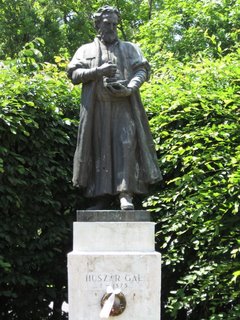 Statue to Gál Huszár, founder of the first printing press in Debrecen
Statue to Gál Huszár, founder of the first printing press in DebrecenOff you go again non-librarians, this is probably not for you …
The Great Library itself is one of the major historical collections in Hungary. Its colonnaded rooms, built in the early 19th century replace those destroyed by fire in 1802 when students tried to save the precious volumes by covering them with their own bodies. In fact the library has long been cherished by the college members and much of the contents is the result of donations. In 1739 the enlightened city council ordered that one copy of each work printed in the town should be presented to the Library. It is therefore far richer in early books than the University Library which dates only from the early 20th century. It contains 530,000 volumes, including 50 manuscript codices, 150 incunabula and 1500 Hungarian books printed before 1711. There are 2,000 volumes printed in Europe before 1600 and we saw a special exhibition of works printed by Christophe Plantin of Antwerp, including titles by Hungarian authors. Our guide explained that since last year state support has halved resulting in many staff being laid off and projects such as retrospective catalogue conversion being put on hold. It is very sad that such a major collection should be left struggling, but it is a situation that many libraries in Hungary have been facing over the past 15 years.
 The Great Library of the Reformed College, Debrecen
The Great Library of the Reformed College, DebrecenBack you all come again, we've finally been "libraried-out".
István returned home to finalise his conference paper in peace leaving us to explore the open air book market on Kossuth tér, part of Hungary's Week of the Book. Time too for a coffee and to search out some flowers to thank our hosts for the wonderful welcome they have given us. When they return from the conference on Sunday we will probably have moved on, taking with us warm and happy memories of our time here. Kösöznöm szépen István és Ibolya you have completely spoilt us!
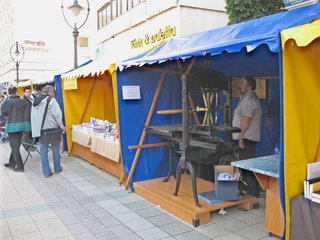 German hand printing press at the book fair, Debrecen
German hand printing press at the book fair, DebrecenFriday 9th June 2006, Debrecen, Hungary
This has been our last full day here. It has been warm, hot even, and we have walked until our feet ache. Yes we could have caught the bus or tram but we would have missed so much of the city suburbs with its legacy of communist housing, a cool enjoyable walk through the shady park surrounding the thermal baths and a more thorough investigation of the University campuses with their attractive gardens and statues. Many of these statues obviously date from the socialist regime before the change but there are also many bronze busts and statues of former notable figures of the town.
 A few of the many housing blocks from before the Change in 1989, Debrecen
A few of the many housing blocks from before the Change in 1989, Debrecen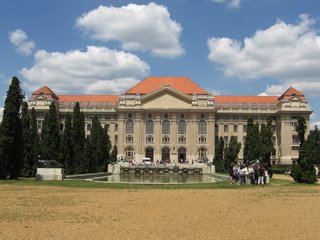 University of Debrecen
University of Debrecen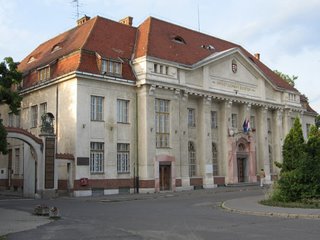 Medical University, Debrecen
Medical University, Debrecen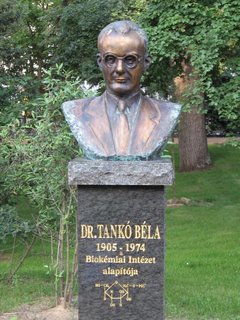 One of the busts in the grounds of the Medical Clinics, Debrecen
One of the busts in the grounds of the Medical Clinics, DebrecenWhat was it Dr Tankó discovered?
It has been a relaxing day where we have pottered around the streets, explored the shopping areas, spent lots of time in the cool internet café and enjoyed bowls of veal soup for lunch and cakes and coffee during the afternoon. Our intention to visit the Deri museum was thwarted yet again when we arrived too late to see anything before closing time. We did however discover the cathedral, a delightful baroque building on a modest scale. It was a charming, well proportioned building with yellow twin towers on the outside, while inside were painted ceilings and an elaborate dark wood pulpit decorated in gold.
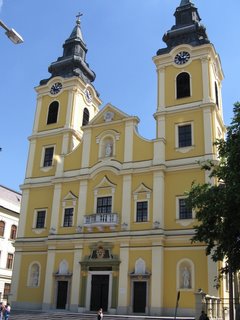 Cathedral, Debrecen
Cathedral, DebrecenThis evening we went to the little restaurant on the medical campus for a light snack. Unfortunately we find Hungarian food frequently has far too much salt for our liking. Paprika is fine but the cheese and meat dishes are often very salt indeed. Unfortunately this was the case this evening. We returned to our room feeling really thirsty.
So not much news for our final day in Debrecen but we will leave tomorrow with very happy memories. We hope we will have the opportunity to reciprocate the hospitality we have been shown one day.
